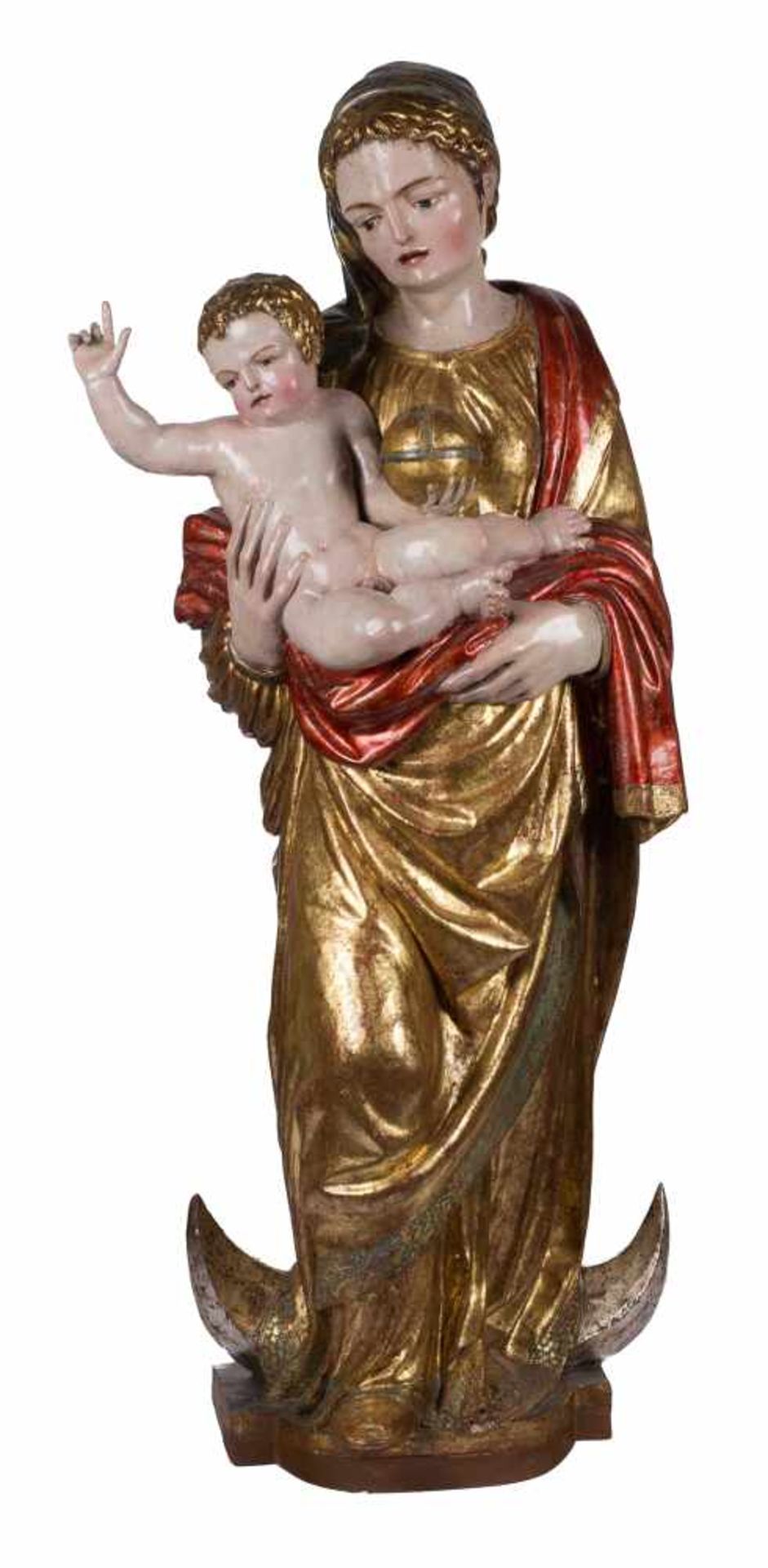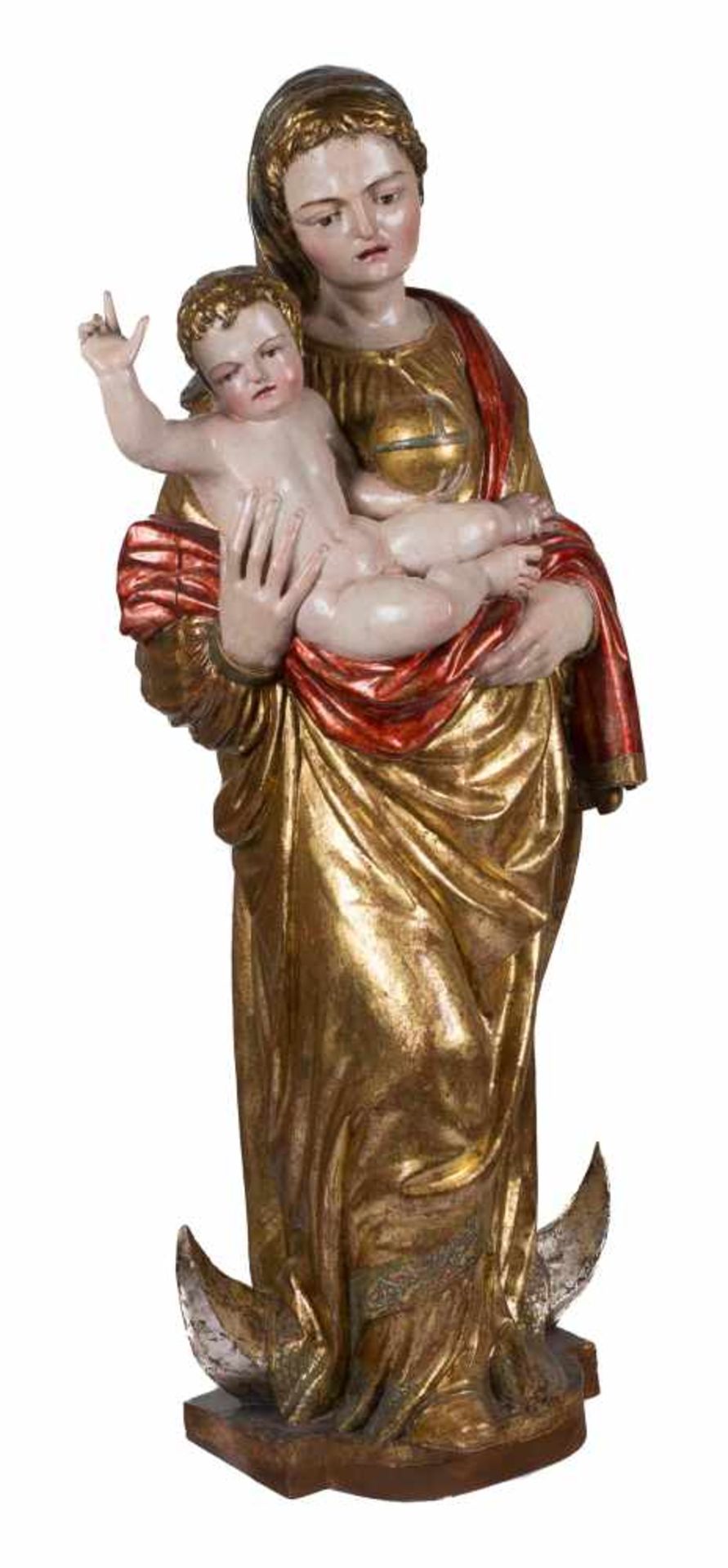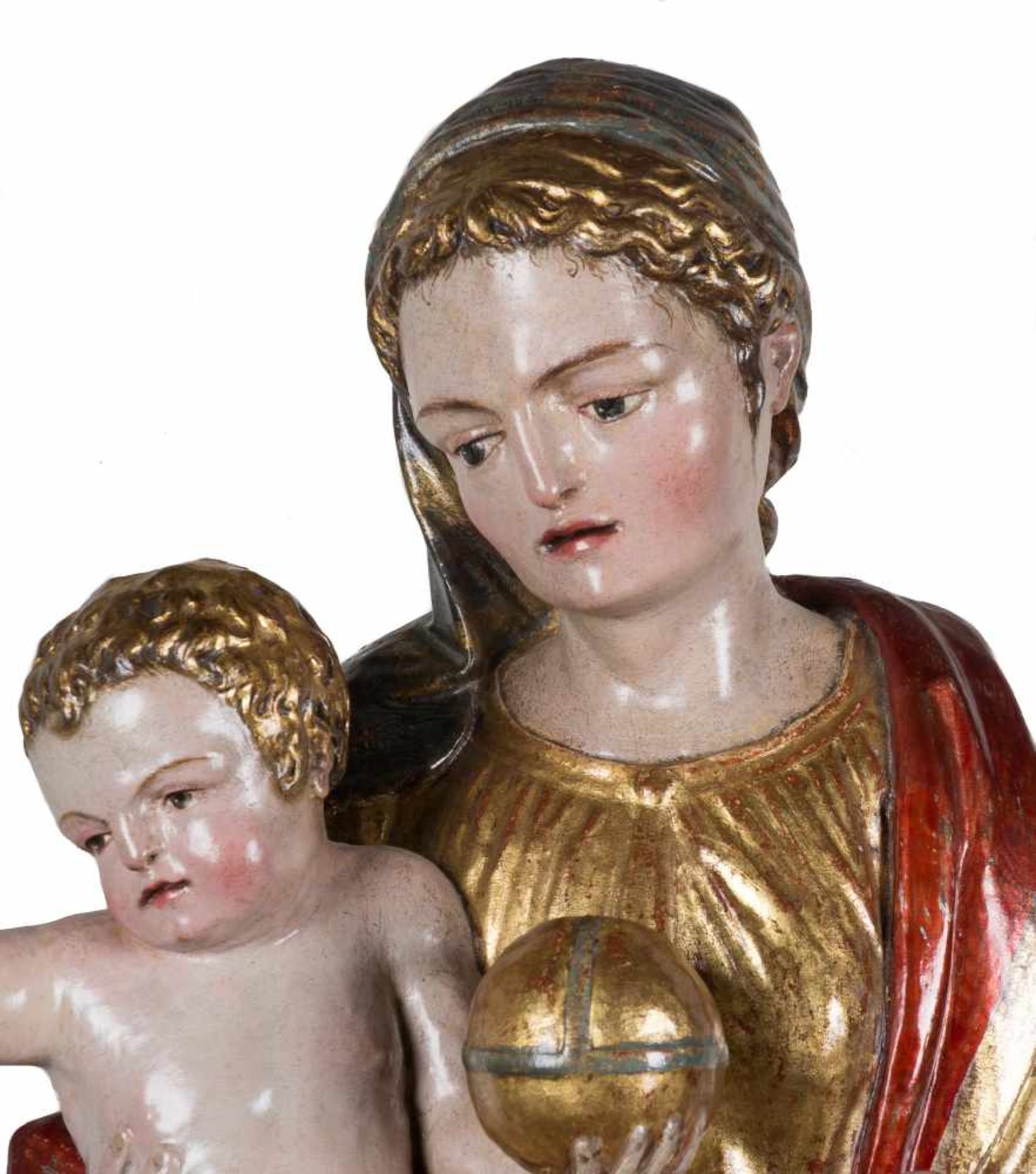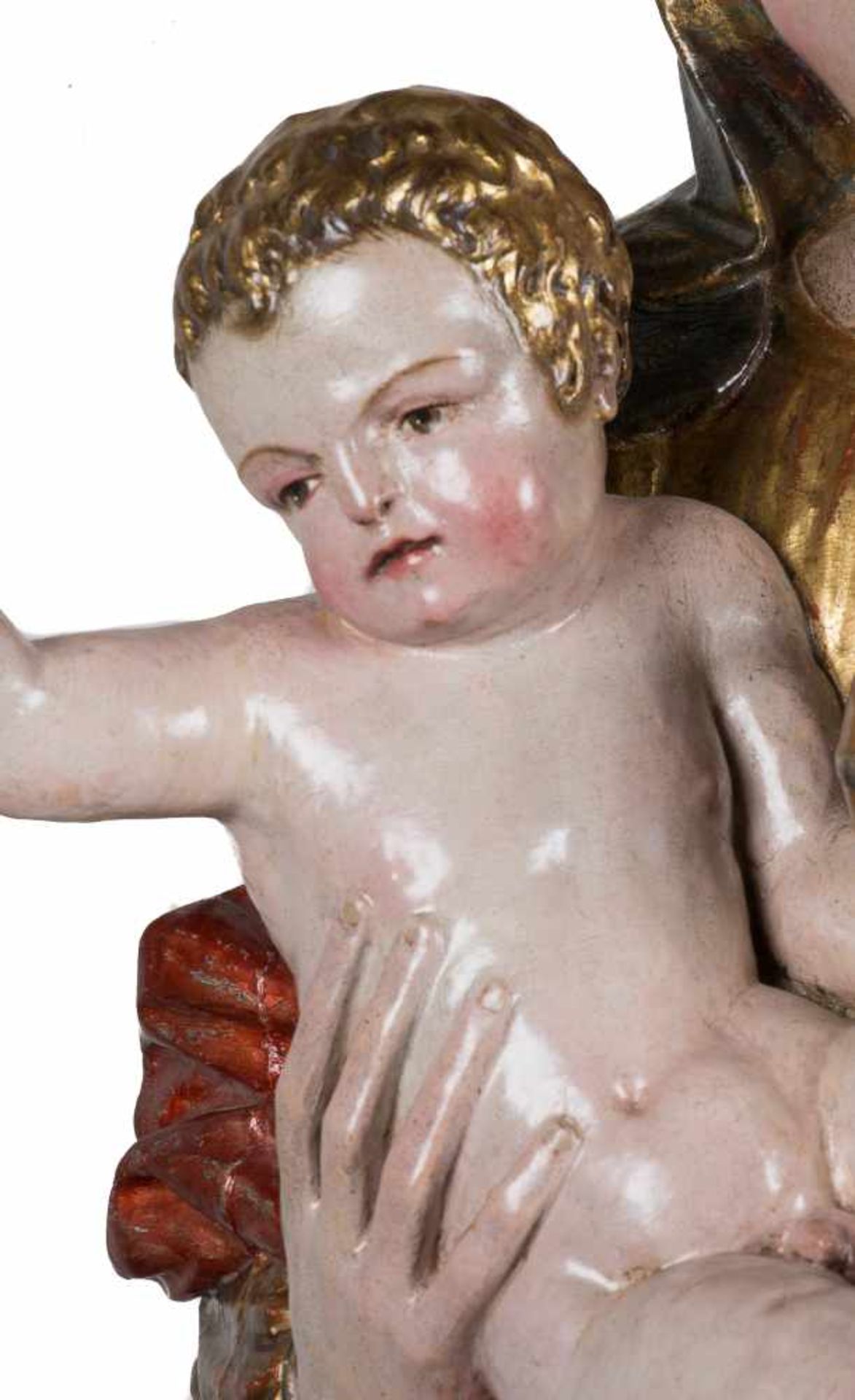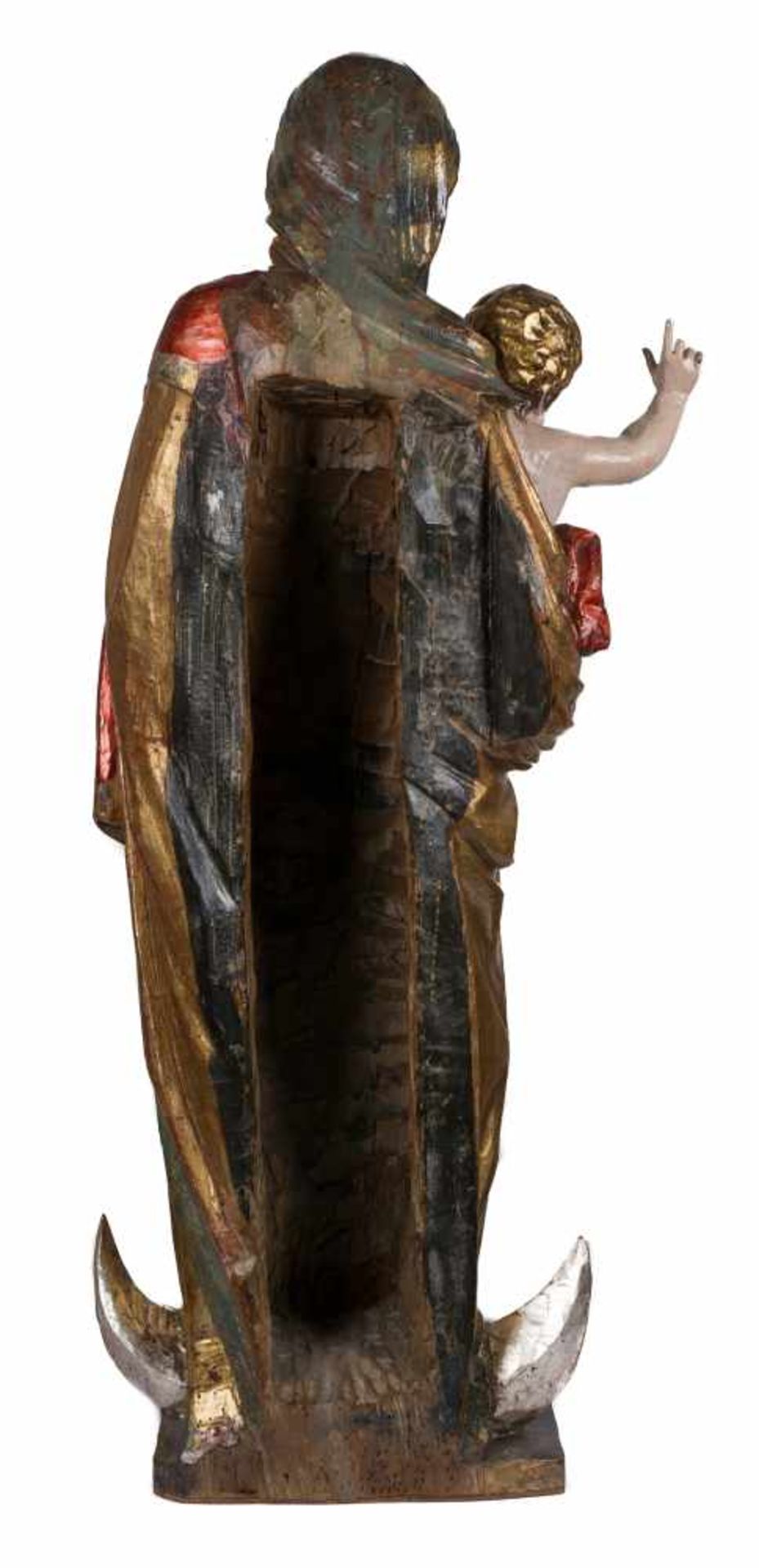17
Arnao de Bruselas (Arnao Spierincks or Spierins) (Brussels, - Logroño, 1564)
"Madonna and Child"
Carved, gilded and polychromed wooden sculpture. Circa 1545 - 1550
Height: 95 cm.
As Professor Jesús María Parrado del Olmo notes in his report on this piece:
Arnao de Bruselas is a great sculptor of the Spanish Renaissance, although there is not much documented data on his activity. We know that from 1536 he was registered as having completed his training at the great sculptor Damián Forment’s workshop in Zaragoza. Even so, his very definite style has meant that a large amount of work in different locations in the south of Navarra, the Basque Country and La Rioja can be attributed to him. He appears to have worked for influential workshops owned by entrepreneur sculptors, particularly Juan de Beaugrant and Andrés de Araoz.
It is confirmed that he collaborated with Forment on the creation of the Main Altarpiece in Santo Domingo de la Calzada Cathedral, which was essentially completed between 1537 and 1540, and would have brought him into contact with the painter Andrés de Melgar, who polychromed the reredos, and was a disciple of Alonso Berruguete. Through this means, or maybe through directly contemplating work by the great Castilian master, Arnao developed a style full of vitality and movement, becoming the best exponent of what is known as Northern Spanish “manierismo expresivista” (Expressivist Mannerism), which he interprets with great elegance in attitudes and compositions.
The Madonna and Child analysed here conforms to his style. The way it is carved avoids a straight, forward-facing pose by counterposing the right leg, which pushes the image forwards. This movement is reinforced by the use of inclined folds in the clothing, which fall to the feet in wide curves. It is worth pointing out the red edging on the cloak, used to gather the Child while barely touching him, as a sign of respect for divinity. The edge falls from the left shoulder to the lap and comes in contact with the right arm to again fall on the opposite arm. It shows a search for elegant artifice. This Mannerism can also be appreciated in the Child’s forced posture, in which his legs are half stretched out and make a right angle with the body, showing a very careful treatment of child anatomy. The Child has a spherical head, with fine blonde locks attached to the cranium. Another outstanding point is the way a small lock falls onto his forehead.
The head of the Virgin Mary has a rather melancholy elegance in its expression. She has a lightly pointed chin, fine lips and a straight nose. Her head is completely covered by the headcloth, apart from the curving locks of hair, which appear above her forehead, and which fall into two locks which fall on the face and behind the left ear. The polychrome completes these locks with paint.
The polychroming is excellent and underlines the beauty of this depiction of the Virgin Mary. Gilt predominates on the clothing, only contrasted by the intense red of the edge of the cloak on which the Child rests, which is undoubtedly an allusion to his tragic destiny, as it is a symbol of blood and sacrifice on the cross. This predominance of gold is a symbol of divine light and alludes to the role of the Virgin Mary as the bearer of divinity. Her hair is also blonde. The “estofado” technique is reserved for the outline of the hand and that of the tunic. The first displays vegetation elements repeated in a series, executed with sgraffiti technique. The second is simpler, with flecks on a blue background.
This extremely beautiful sculpture is undoubtedly the work of Arnao de Bruselas, which can be confirmed through the stylistic and typological similarities with other feminine figures and sculptures of infants which appear among Arnao’s work. The way of arranging the headdress by letting some small locks of hair fall free is typical of the sculptor, as can be seen in his depiction of the Virgin Mary in the Adoration of the Magi relief in the Alberite reredos (from 1549), and in his Virgin Mary in the Adoration of the Shepherds in the Abalos reredos. In the same way, there are links with some of the images of the altarpiece of the Church of Santa Maria de Palacio in Logroño (from 1553), as well as the Virgin Mary in the Adoration of the Shepherds, or the Visitation sculptural group, which has a similar profile to this Madonna and Child, with a straight nose and pointed chin. The way the clothes fall to the feet is also similar.
In the Visitation in the Lapoblación reredos, there are equivalent correlations. However, there are closer similarities in the typology of the Child to other depictions of infants by Arnao de Bruselas. The rounded head, with plastered down ringlets and a lock hanging over the forehead, as well as the thickset anatomy can also be appreciated in the angels that surround the Asuncion of the aforementioned Alberite reredos, especially in the one that has a horn on its head. It is the same with the naked children placed on the busts of saints in the Santa Maria de Palacio altarpiece, which are practically identical to the Child with this Madonna when analysed, as are the children which accompany the relief of Charity in the same altarpiece.
The polychroming of the image enables the dating of it to the second quarter of the 16th century, given that there is no work with the tip of a paintbrush, or even decoration of branches, techniques which were introduced in the third quarter of the century. This allows us to date it to circa 1550, if the similarities to the carving of the sculpture with the aforementioned Alberite and Santa Maria de Palacio altarpieces are taken into account.
Reference bibliography:
RUIZ-NAVARRO PÉREZ, Julián: Arnao de Bruselas: imaginero renacentista and su obra en el valle medio del Ebro. Logroño, 1981.
FERNÁNDEZ PARDO, Francisco (coordinator): La escultura en la ruta jacobea: Arnao de Bruselas. Logroño, published by Fundación Bancaja, 2006
One of the Child’s right-hand fingers is missing.
Arnao de Bruselas (Arnao Spierincks or Spierins) (Brussels, - Logroño, 1564)
"Madonna and Child"
Carved, gilded and polychromed wooden sculpture. Circa 1545 - 1550
Height: 95 cm.
As Professor Jesús María Parrado del Olmo notes in his report on this piece:
Arnao de Bruselas is a great sculptor of the Spanish Renaissance, although there is not much documented data on his activity. We know that from 1536 he was registered as having completed his training at the great sculptor Damián Forment’s workshop in Zaragoza. Even so, his very definite style has meant that a large amount of work in different locations in the south of Navarra, the Basque Country and La Rioja can be attributed to him. He appears to have worked for influential workshops owned by entrepreneur sculptors, particularly Juan de Beaugrant and Andrés de Araoz.
It is confirmed that he collaborated with Forment on the creation of the Main Altarpiece in Santo Domingo de la Calzada Cathedral, which was essentially completed between 1537 and 1540, and would have brought him into contact with the painter Andrés de Melgar, who polychromed the reredos, and was a disciple of Alonso Berruguete. Through this means, or maybe through directly contemplating work by the great Castilian master, Arnao developed a style full of vitality and movement, becoming the best exponent of what is known as Northern Spanish “manierismo expresivista” (Expressivist Mannerism), which he interprets with great elegance in attitudes and compositions.
The Madonna and Child analysed here conforms to his style. The way it is carved avoids a straight, forward-facing pose by counterposing the right leg, which pushes the image forwards. This movement is reinforced by the use of inclined folds in the clothing, which fall to the feet in wide curves. It is worth pointing out the red edging on the cloak, used to gather the Child while barely touching him, as a sign of respect for divinity. The edge falls from the left shoulder to the lap and comes in contact with the right arm to again fall on the opposite arm. It shows a search for elegant artifice. This Mannerism can also be appreciated in the Child’s forced posture, in which his legs are half stretched out and make a right angle with the body, showing a very careful treatment of child anatomy. The Child has a spherical head, with fine blonde locks attached to the cranium. Another outstanding point is the way a small lock falls onto his forehead.
The head of the Virgin Mary has a rather melancholy elegance in its expression. She has a lightly pointed chin, fine lips and a straight nose. Her head is completely covered by the headcloth, apart from the curving locks of hair, which appear above her forehead, and which fall into two locks which fall on the face and behind the left ear. The polychrome completes these locks with paint.
The polychroming is excellent and underlines the beauty of this depiction of the Virgin Mary. Gilt predominates on the clothing, only contrasted by the intense red of the edge of the cloak on which the Child rests, which is undoubtedly an allusion to his tragic destiny, as it is a symbol of blood and sacrifice on the cross. This predominance of gold is a symbol of divine light and alludes to the role of the Virgin Mary as the bearer of divinity. Her hair is also blonde. The “estofado” technique is reserved for the outline of the hand and that of the tunic. The first displays vegetation elements repeated in a series, executed with sgraffiti technique. The second is simpler, with flecks on a blue background.
This extremely beautiful sculpture is undoubtedly the work of Arnao de Bruselas, which can be confirmed through the stylistic and typological similarities with other feminine figures and sculptures of infants which appear among Arnao’s work. The way of arranging the headdress by letting some small locks of hair fall free is typical of the sculptor, as can be seen in his depiction of the Virgin Mary in the Adoration of the Magi relief in the Alberite reredos (from 1549), and in his Virgin Mary in the Adoration of the Shepherds in the Abalos reredos. In the same way, there are links with some of the images of the altarpiece of the Church of Santa Maria de Palacio in Logroño (from 1553), as well as the Virgin Mary in the Adoration of the Shepherds, or the Visitation sculptural group, which has a similar profile to this Madonna and Child, with a straight nose and pointed chin. The way the clothes fall to the feet is also similar.
In the Visitation in the Lapoblación reredos, there are equivalent correlations. However, there are closer similarities in the typology of the Child to other depictions of infants by Arnao de Bruselas. The rounded head, with plastered down ringlets and a lock hanging over the forehead, as well as the thickset anatomy can also be appreciated in the angels that surround the Asuncion of the aforementioned Alberite reredos, especially in the one that has a horn on its head. It is the same with the naked children placed on the busts of saints in the Santa Maria de Palacio altarpiece, which are practically identical to the Child with this Madonna when analysed, as are the children which accompany the relief of Charity in the same altarpiece.
The polychroming of the image enables the dating of it to the second quarter of the 16th century, given that there is no work with the tip of a paintbrush, or even decoration of branches, techniques which were introduced in the third quarter of the century. This allows us to date it to circa 1550, if the similarities to the carving of the sculpture with the aforementioned Alberite and Santa Maria de Palacio altarpieces are taken into account.
Reference bibliography:
RUIZ-NAVARRO PÉREZ, Julián: Arnao de Bruselas: imaginero renacentista and su obra en el valle medio del Ebro. Logroño, 1981.
FERNÁNDEZ PARDO, Francisco (coordinator): La escultura en la ruta jacobea: Arnao de Bruselas. Logroño, published by Fundación Bancaja, 2006
One of the Child’s right-hand fingers is missing.
From Europe to the New World II
Auktionsdatum
Ort der Versteigerung
Generelle Versandinformationen vom Auktionshaus verfügbar
The purchase price includes the delivery of the lots in the venue of the auction. Transporting to other destinations is at the own risk of the client. The customer must contact "LST", to give the corresponding instructions for such transporting. "LST" is not responsible for the packaging or any accident incurred during transportation.
Wichtige Informationen
Zu Aufgeld und Mehrwertsteuer prüfen Sie bitte das jeweilige Los.
For buyer’s premium and VAT please check particular lot.
AGB
Standard | Standars
CONDITIONS OF THE AUCTION:
I. REGISTRATION. To bid in the room customers must register at the beginning, filling out a form and picking a number that will identify them during the auction. Customers may be required to register in bank references or other guarantee system and if they do not prove the solvency "LST" will not accept bids and award the auction.
II. WRITTEN BIDS. "LST" will accept written bids, which will be formalized in the form provided by the room until the day before the auction. In such auctions, the room will bid in name of the client until the maximum stated in the offer and always at the lowest possible price. If there are two or more bids for the same amount, the one placed first will have the priority. Written bids received in advance, will have priority on the day of the auction.
III. TELEPHONE BIDS. "LST" will allow telephone bids, if interested people contact "LST" days before the auction providing personal data, ID card and the phone number which will be used by the staff of "LST" to call at the time of the auction. The buyer, within all the legal rights is making an offer for the asking price, when applies for telephone bid. "LST" will not take responsibility for any technical defects beyond its control, which may prevent to contact successfully the bidder during the auction.
IV. AUCTIONEER. The auction will be conducted by an auctioneer, director of the auction will be judge and arbitrator of it with full authority in its development, will award the lots to the highest bidder and is able to settle any controversy concerning lots sale, reject bids, divide lots or group them and remover objects from the room. Will be able to, if it is deemed suitable, not accept bids on the auction. His decision will be unappealable.
V. SALE OF LOTS. The lots are awarded to the highest bidder. Once the auctioneer blows the hammer, the buyer becomes responsible of the lot purchased, exempting "LST" of liability to for any damage and / or accidents that may occur. No refunds of lots.
VI. STARTING PRICE. The amount shown in the catalogue as the starting price for each lot will be, as a rule, the minimum selling price, except for exceptional cases where a reservation may be agreed upon with the seller or it set discretionary by the room.
VII. SCALE OF BIDS. The bids are set according to the following scale:
From 50.-€ to 200.-€…………………………………………..at 10.-€
From 200.-€ to 500.-€…………………………………… …25 in 25.-€
From 500.-€ to 1.000.-€………………………………..…..….50 in 50.-€
From 1.000.-€ to 2.000.-€………………………………..…100 in 100.-€
From 2.000.-€ to 5.000.-€……………………………….….250 in 250.-€
From 5.000.-€ to 10.000.-€…………………………………500 in 500.-€
From 10.000.-€ to 20.000.-€……………………………1.000 in 1.000.-€
From 20.000.-€ to 50.000.-€……………………………2.500 in 2.500.-€
From 50.000.-€ to 100.000.-€…………………………..5.000 in 5.000.-€
From 100.000.-€ to 100.000.-€………………………10.000 in 10.000.-€
From 200.000.-€ to 200.000.-€………………………25.000 in 25.000.-€
From 500.000.-€ to 500.000.-€………………………50.000 in 50.000.-€
VIII. RIGHT OF ADMISION. "LST" reserves the right to admission to the auction room and to reject, at its judgment, any purchase order, from clients whose solvency is not duly proved as well as not to sale auctions.
IX. SALE PRICES. The successful bidder of one or more lots must pay "LST" the final sale price achieves at auction, plus the 22 % plus 21% VAT on the commission, at total 26,62 % on Hammer Price.
X. CATALOG DATA. The catalogue data are obtained in order to careful research and advice, however, any responsibility is afforded about its accuracy. The lots will be auctioned in the state in which they are, not accepting any claims in restorations, breakage, damage, imperfections and, even description or numbering mistakes in the catalogue, in case of it, being the burden of the buyers to make sure before the auction that the description matches with their personal opinion about respective lot. The exhibition of the lots is intended to allow a perfect review and study of them.
XI. PAYMENT AND REMOVAL OF LOTS. Payment and removal of the lots will be held no later than five days following the auction. After this period expire without having the buyer removed the lot or lots purchases, it will accrue an expense of custody of 6 euros per day on each lot.
15 days after the auction without having the buyer paid and removes the sold lots, "LST" will inform the seller and there will begin judicial proceeding in order to obtain payment. The delay in payment by the purchaser of his/her sold lots will carry an interest increase at a rate of 1,5% per month.
XII. DELIVERY OF LOTS. The purchase price includes the delivery of the lots in the venue of the auction. Transporting to other destinations is at the own risk of the client. The customer must contact "LST", to give the corresponding instructions for such transporting. "LST" is not responsible for the packaging or any accident incurred during transportation.
XIII. RIGHT OF FIRT REFUSAL AND REPURCHASE. "LST" in order to article 38 of "Ley 16/1985 de 25 Junio del Patrimonio Histórico Español" (BOE. 155 June 29, 1985), will notify in advance to the Ministry of Culture, the content of their catalogues. Concerning the lots subject to the legislation referred to in the preceding paragraph, the Administration may exercise the rights of first refusal and repurchase according to the law. "LST" will watch over the protection of Artistic, Historical and Bibliographical Heritage of Spain. For customers out of European Community, a tax for export is required by the Administration.
XIV. VALUE ADDED TAX (I.V.A). This tax will be accrued on commissions of "LST" for buyers, using the rates prevailing on the date of the auction.
XV. DATA PROTECTION. In order to the "Ley 15/1999 de 13 de Diciembre, de Protección de Datos de Carácter Personal", the client authorize "LST", the inclusion of their data in a customer file, and for the promotion by "LST" of the objects at all times the rights of access, rectification or deletion of personal data by sending the appropriate request to the following address: LA SUITE SUBASTAS, C/ Conde Salvatierra, 8, 08006. Barcelona.
XVI. EXPRESS LEGAL JURISDICTION. These Conditions are governed by and interpreted in accordance with the rules of Spanish law. The mere act of participating in the auction as seller, buyer or bidder, implies acceptance of these Terms and Conditions.
Sales operations are understood to be held at the registered office of "LST", C/ Conde de Salvatierra, 8, 08006. Any dispute shall be taken to the competent courts of Barcelona, expressly waiving any other jurisdiction, in accordance with Article 55 of the "Ley de Enjuiciamiento Civil".












